 Abe Lincoln was certainly no stranger to horses. The President was quite fond of the animals. History tells us that there was a fire at the White House stables. In fact, the stables were engulfed by fire. President Lincoln tried to run into the burning stable to save his son's ponies. President Lincoln had to be physically restrained.
Abe Lincoln was certainly no stranger to horses. The President was quite fond of the animals. History tells us that there was a fire at the White House stables. In fact, the stables were engulfed by fire. President Lincoln tried to run into the burning stable to save his son's ponies. President Lincoln had to be physically restrained.
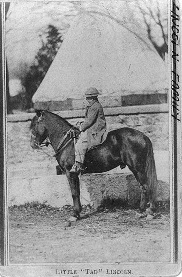 Lincoln's children Willie and Tad had ponies. Willie had a pony at the White House, and insisted on riding it every day. Tad also rode the pony; he was so small when he learned to ride it that his feet stuck straight out from the saddle. On Tad's tenth birthday, April 4, 1863 (after Willie had died), a new pony arrived at the White House. The Lincolns still had Willie's pony, but this new pony became Tad's.
Lincoln's children Willie and Tad had ponies. Willie had a pony at the White House, and insisted on riding it every day. Tad also rode the pony; he was so small when he learned to ride it that his feet stuck straight out from the saddle. On Tad's tenth birthday, April 4, 1863 (after Willie had died), a new pony arrived at the White House. The Lincolns still had Willie's pony, but this new pony became Tad's.
Lincoln owned several horses throughout his life including Tom, Belle, Old Buck, and a reddish-brown horse named Robin (who was called "Old Bob"). Lincoln rode Old Bob when on the circuit as a lawyer. "Lincoln left Old Bob in Springfield when he went to Washington, D.C. There, Lincoln got a new horse, whom someone named 'Old Abe.' When Abraham Lincoln went to the Soldier's Home just outside of Washington, it was on Old Abe that he rode. Lincoln told this story to Marshal Lamon about an assassination attempt while on his way to the Soldier's Home:
'I was jogging along at a slow gait, immersed in deep thought, when suddenly I was aroused--I may say the arousement lifted me out of my saddle as well as out of my wits--by the report of a rifle. [He heard a bullet whistle past his ear.] Old Abe, with one reckless bound, unceremoniously separated me from my eight-dollar plug-hat, with which I parted company without any assent, expressed or implied, upon my part. At a break-neck speed we soon arrived in a haven of safety.
'I can truthfully say that one of the Abes was frightened on this occasion, but modesty forbids my mentioning which of us is entitled to that distinguished honor." Pets of Abraham Lincoln
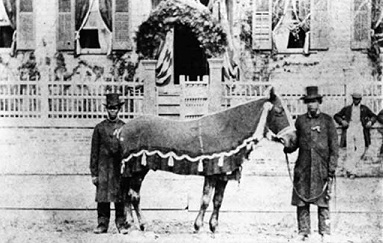 "In 1865, Abraham Lincoln was honored by the inclusion of a caparisoned horse at his funeral. When Lincoln's funeral train reached Springfield, Illinois, his horse, Old Bob, who was draped in a black mourning blanket, followed the procession and led mourners to Lincoln's burial spot. A riderless horse or caparisoned horse (in reference to its ornamental coverings, which have a detailed protocol of their own) is a single horse, without a rider, and with boots reversed in the stirrups, which sometimes accompanies a funeral procession. The horse follows the caisson carrying the casket. A riderless horse can also be featured in military parades to symbolize fallen soldiers. ...The custom is believed to date back to the time of Genghis Khan, when a horse was sacrificed to serve the fallen warrior in the next world. The caparisoned horse later came to symbolize a warrior who would ride no more. ...
"In 1865, Abraham Lincoln was honored by the inclusion of a caparisoned horse at his funeral. When Lincoln's funeral train reached Springfield, Illinois, his horse, Old Bob, who was draped in a black mourning blanket, followed the procession and led mourners to Lincoln's burial spot. A riderless horse or caparisoned horse (in reference to its ornamental coverings, which have a detailed protocol of their own) is a single horse, without a rider, and with boots reversed in the stirrups, which sometimes accompanies a funeral procession. The horse follows the caisson carrying the casket. A riderless horse can also be featured in military parades to symbolize fallen soldiers. ...The custom is believed to date back to the time of Genghis Khan, when a horse was sacrificed to serve the fallen warrior in the next world. The caparisoned horse later came to symbolize a warrior who would ride no more. ...
In the United States, the caparisoned horse is part of the military honors given to an Army or Marine Corps officer who was a colonel or above; this includes the President, by virtue of having been the country's commander in chief and the Secretary of Defense, having overseen the armed forces. Alexander Hamilton, former Secretary of the Treasury (1789-1795) was the first American to be given the honor. Historian Ron Chernow noted that Hamilton's gray horse followed the casket 'with the boots and spurs of its former rider reversed in the stirrups.' Abraham Lincoln was the first president of the United States to be officially honored by the inclusion of the caparisoned horse in his funeral cortege, although a letter from George Washington's personal secretary recorded the president's horse was part of the president's funeral, carrying his saddle, pistols, and holsters. Traditionally, simple black riding boots are reversed in the stirrups to represent a fallen leader looking back on his troops for the last time." ![]() Riderless Horse
Riderless Horse ![]()
This statue of Abraham Lincoln and his horse, Old Bob, was created by Ivan Schwartz. The statue is made of bronze. It is life size and done as true to the times as possible. It should also be noted that old photos, clothing and skulls were studied. The skills of a forensic scientist were also used by New York-based StudioEIS. "For the statue of Lincoln, Mr. Schwartz and his team examined all the photos taken of the president and the life casts of his face and hands from 1860. Lincoln's surviving coat and top hat, now in the collection of the Smithsonian's National Museum of American History, were measured to accurately reflect the president's daily garb. 'He was 6 feet 4 inches, and wore a size 14 shoe,' notes the artist.
The saddled horse next to the sculpted Lincoln also took intensive research. The artists studied 19th-century equestrian statues in New York City and a photo of Old Bob, Lincoln's favorite horse. In consultation with equine experts, they chose an American Standardbred as the model for the sculpture." Honest Abe and Old Bob.![]()
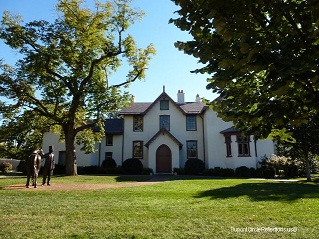

Lincoln's Cottage
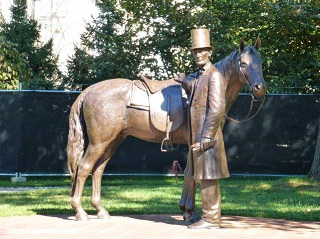

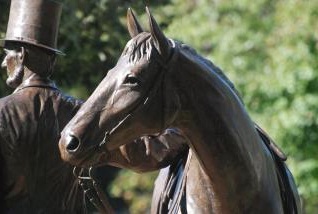
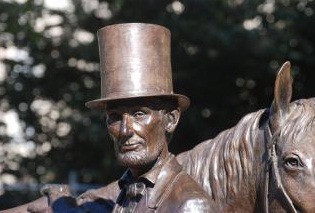
For More Information:
Everything LincolnAbraham Lincoln and His Horse, Old Bob or Old Robin
President Lincoln's Cottage at the Soldiers' Home U.S. Military Asylum; The Old Soldiers' Home Washington, DC/Old Bob Statue
Lincoln's Hitching Post and The New York Avenue Presbyterian Church, Washington, DC
Honest Abe and His Horse Arrive in Washington, DC

